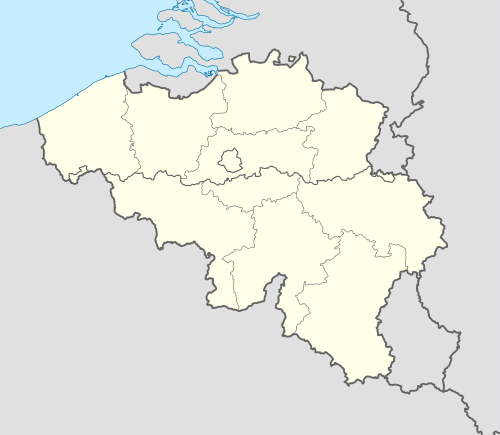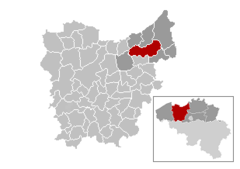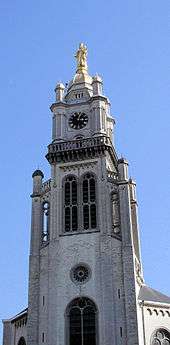Sint-Niklaas
Sint-Niklaas (Dutch: [ˌsɪnt nɪˈklaːs] (![]()
Sint-Niklaas | |
|---|---|
 | |
 Flag .svg.png) Coat of arms | |
 Sint-Niklaas Location in Belgium
Location of Sint-Niklaas in East Flanders  | |
| Coordinates: 51°10′N 04°08′E | |
| Country | Belgium |
| Community | Flemish Community |
| Region | Flemish Region |
| Province | East Flanders |
| Arrondissement | Sint-Niklaas |
| Government | |
| • Mayor | Lieven Dehandschutter (N-VA) |
| • Governing party/ies | N-VA - SP.A - Green |
| Area | |
| • Total | 83.80 km2 (32.36 sq mi) |
| Population (2018-01-01)[1] | |
| • Total | 76,756 |
| • Density | 920/km2 (2,400/sq mi) |
| Postal codes | 9100, 9111, 9112 |
| Area codes | 03 |
| Website | www.sint-niklaas.be |
Sint-Niklaas is the capital and major city of the Waasland region straddling the East Flanders and Antwerp provinces. The city is known for having the largest market square in Belgium. At one point this square also boasted the largest Christmas tree, and the largest easter egg in Europe.[2]
History
Thirteenth-century origins
Although some traces of pre-Roman activity have been found on the territory of Sint-Niklaas, the regional centre during Roman times was neighbouring Waasmunster, better located on the river Durme. Belsele was already mentioned in a 9th-century document. The history of Sint-Niklaas proper, however, starts in 1217, when the bishop of Tournai, following advice from the local clergy, founded a church dedicated to Saint Nicholas here. The new parish was to depend on the See of Tournai until the middle of the 16th century. Politically, however, it was part of the County of Flanders. The power of Flanders at that time favoured the rapid economic development of the city, which became the administrative centre of the region in 1241. A document dated from 1248 records that Margaret II, Countess of Flanders, ceded additional territory to the parish of Sint-Niklaas with the proviso that it would remain bare, which explains the unusual size of the central market square today.
14th to 17th century
The city was never walled, which made it an easy target for conquest. In 1381, it was engulfed by fire and plundered. However, the central location of Sint-Niklaas between Ghent and Antwerp, not far from the Scheldt, favoured further development. By 1513, Emperor Maximilian had granted the city the right to hold a weekly market. Around 1580, the church of Saint Nicholas suffered heavy damage from roving iconoclasts. The 17th century was generally a period of prosperity that was marked by economic growth, mostly in the flax and wool industries. This was also the time when Sint-Niklaas was endowed with administrative buildings and three cloistered communities (Oratorians, Franciscans, and Black Sisters), which provided educational, religious, and medical services to the region. On 25 May 1690 another fire destroyed most of the city. During this period the famous Spanish noble family Sanchez de Castro y Toledo resided in Sint-Niklaas.[3]
18th century until now
In the 18th century, the Austrian regime was favourable to Sint-Niklaas. The flagship textile industry adapted well to mechanization and added cotton products to its portfolio in 1764. At the end of the century, the French Revolution brought its mixture of religious intolerance and modern administration to the city. Napoleon came to visit Sint-Niklaas in 1803 and officially promoted it to the rank of city. The 19th century witnessed a general decline in the textile industry. Several new buildings were erected, including the current city hall and the Onze-Lieve-Vrouwekerk (Church of Our-Lady). After World War II, the textile industry went through a crisis. Today, the historic centre of the city has become mostly a shopping and services district.
Tour of Flanders
The Tour of Flanders (Flemish, Ronde van Vlaanderen ) bicycle road race moved its start to the market square at Sint-Niklaas from Ghent in 1977, mainly because the great square provided close proximity for the growing number of spectators. By 1988 the start had grown into a two-day affair with a spectacle presented by BRT television the previous night. Since 1998 the start of the race has taken place in Brugge.
Heritage





- The main Church of Saint Nicholas was founded in the 13th century and gave its name to the city. After heavy damage in the 16th century, the interior was redone in the Baroque style.
- St. Joseph Minor Seminary, catholic school.
- The Church of Our Lady, built in the 19th century, famous for its Byzantine revival interior, and 6m tall statue of our lady on top, covered in fine gold.
- Town Hall, in gothical revival style was built after the old hall burned down.
- The largest market square in Belgium, founded by Margaret II, Countess of Flanders.
- The Gerardus Mercator Museum traces the history of cartography back to its origins. The museum also houses two original globes that belonged to the famous cartographer.
- Other churches and museums include: Saint Joseph, Christ the King, Saloons of Fine Arts and Zwijgershoek.
Events
- On the first weekend of September, Sint-Niklaas hosts an international balloon meeting (Vredefeesten) and a three-day music festival called "Villa Pace".
- During the last week of the year, Sint-Niklaas is the host of the Flanders Volley Gala, an international volleyball tournament.
- The city keeps seven giants: Janneken, Mieke, Sinterklaas and Zwarte Piet, and the three Magi: Caspar, Melchior, and Balthasar.
Transportation
Because of its location on the vital axis from Ghent to Antwerp, Sint-Niklaas has excellent connections by train and car. The E17, one of Belgium's busiest highways, passes the city; the N16 dual carriageway leads to Mechelen and Brussels.
Trains depart every half-hour to Ghent and Antwerp and hourly to Brussels, Mechelen and Leuven from the new railway station. The city also has an extensive network of buslines, both regional and local. Throughout the city's main thoroughfares, buses drive in designated lanes.
Sint-Niklaas was awarded the title of Most Pedestrian Friendly City in Flanders after the restoration of its central Market area.
Mayors
Mayors since the end of World War II:
- Henri Heyman (Catholic) (1933–1946);
- Romain De Vidts (CVP, now CD&V) (1947–1962);
- Frantz Van Dorpe (CVP, now CD&V);
- Paul De Vidts (CVP, now CD&V) (1977–1988);
- Lieven Lenaerts (CVP, now CD&V) (1995–1996);
- Jef Foubert (CVP, now CD&V) (1997–2000);
- Freddy Willockx (SP.A) (1989–1994 and 2001 - June 2010).
- Christel Geerts, the first female mayor of Sint-Niklaas. (SP.A) (July 2010 - 2012)
- Lieven Dehandschutter (N-VA) (2013 - )
Famous citizens
- Alex Callier and Raymond Geerts, musicians (Hooverphonic)
- Philip Coppens, author (1971–2012)
- Maurits Coppieters, politician (1920–2005)
- Sean Dhondt, leadsinger 'Nailpin', born in Sint-Niklaas
- Gustaaf Joos, Cardinal
- August de Maere, engineer, creator of the Zeebrugge Port (1802–1885)
- Martin De Prycker, engineer, CEO of Barco (b. 1955)
- Els de Schepper, Flemish actress, comedian and writer (b. 1965)
- Tom Lanoye, author (b. 1958)
- Ilyo Hansen, author (b.1966)
- Jan Vertonghen, Footballer, (b. 1987)
- Sven Maes, DJ (b. 1973)
- Daniël Ost, florist (b. 1955)
- Henri Van Severen, Gold embroiderer
- Antoon Stillemans, bishop of Ghent
- Luis Siret, archaeologist and illustrator (1869–1934)
- Marc Sleen, comics artist (b. 1922)
- Woodie Smalls, rapper (b. 1996)
- Paul Snoek, poet (1933–1981)
- Tom Steels, cyclist (b. 1971)
- Edgar Tinel, composer, born in Sinaai (1854–1912)
- Dirk Jan Kinet, interior designer (b. 1966)
- Marc Vael, computer scientist, (b. 1967)
- Wouter Van Bellingen, politician
- Sandrine Van Handenhoven, artist (b. 1984)
- Anton van Wilderode, poet (1918–1998)
- Erik Wijmeersch, Athlete (b.1970)
- Angelo Vermeulen, visual artist (b.1971)
- Sylvestre Salamu, rapper (b.1996)
International relations
Twin towns — Sister cities
Sint-Niklaas is twinned with:
References
- "Wettelijke Bevolking per gemeente op 1 januari 2018". Statbel. Retrieved 9 March 2019.
- "World's Biggest Easter Egg Goes On Show". Gettyimages. 2005-03-24.
- Recuerdos españoles en Flandes, Volume 3
External links
| Wikimedia Commons has media related to Sint-Niklaas. |

- Official website - Information available in Dutch and limited information available in English and French
- Flemish couples don't want to be wed by Wouter, The Observer article on racism in Sint-Niklaas
